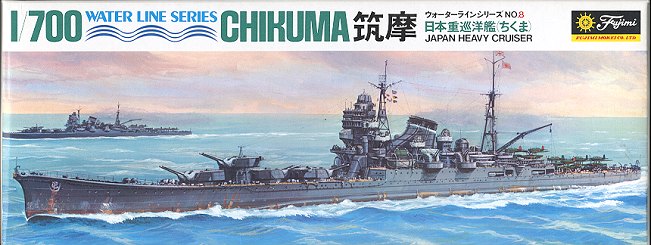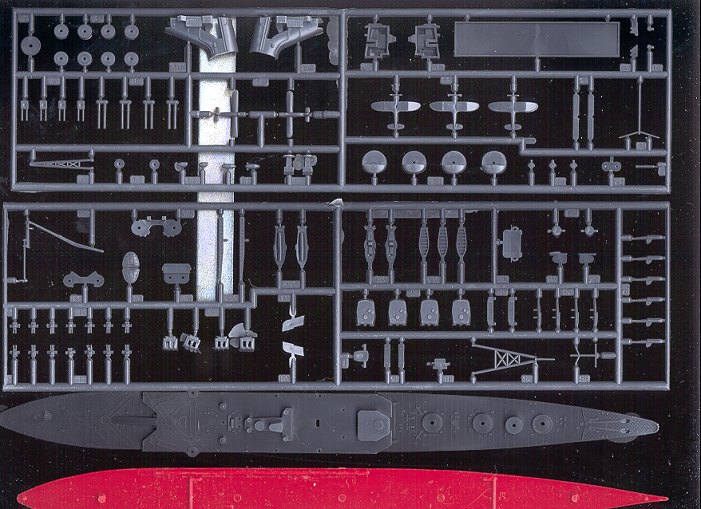
| KIT: | Fujimi 1/700 IJN Heavy Cruiser 'Chikuma ' |
| KIT # | 8 |
| PRICE: | ¥400 (or $21.49 from some US retailers) |
| DECALS: | A flag |
| REVIEW & | |
| NOTES: | Waterline kit |

| HISTORY |
The heavy cruiser Chikuma is one of a two ship class; theother ship being the Tone. Both are unusual to Western eyes because allthe offensive armament, in this case 8 8" guns in four turrets, is in thefront of the ship. On the aft decking is a floatplane platform on which the fiveaircraft could be carried. These were the newest and last heavy cruisers builtfor the Japanese Navy to use in WWII.
For some other information.She was launched 19 March, 1938; completed 20 May, 1939; displaces 15,200 tons, can go 35 knots and has a crewof 874. In addition to the main battery of 8" guns, she carried 8 5"dual purpose guns and 24 of the potent 'long lance' torpedoes that were soeffective. Maybe because of the large number of scouting floatplanes, neither ofthese ships saw much in the way of gun action, spending much of their timeescorting the fleet carriers. Of course, it might have been the 57 25mmanti-aircraft guns that had something to do with it as well! Except forbroadsides, at least two of the main guns would have been pretty ineffectiveduring gun combat since their firing arc was so limited.
Chikuma'ssister ship, the Tone, was sunk in late 1945 while at anchorage in Kure.The Chikuma was severely damaged 25
October, 1944 by air torpedo attack from US TF 77 during the battle of Samar and scuttled11° 22' N, 126° 16' E by destroyer Nowake.
| THE KIT |

I reallydidn't want to say this, but it will take up part of a line: "If you'veseen one Fujimi/Aoshima/Tamiya/Hasegawa waterline kit, you've seen themall". Well, except for the most recent kits that are 2-3 times moreexpensive, that is. When I was in Japan in the early 70's these four companieshad done every wartime IJN ship that there had ever been. They all followed asimilar pattern. The hull and deck is one piece. No messing with warped hullsides and trying to glue them onto the main deck. They are nice a sturdy. Thereis a weight to give them some heft (not in the subs, though), and the bottomplate is red to represent the waterline. Actually, you should paint that a sortof rust red color for that is the proper shade for IJN ships.
Ifyou take a look at the image above, you will see what I mean. The parts are allvery nicely molded, though the kit is showing it's age and some flash iscreeping in. No engraved panel lines here. No multi-variant sprues, either.There are ejector pin marks on lots of the smaller pieces like the littleairplanes and boats. There are some sink marks in some parts, but nothing major.Not shown in any clarity is the plethora of lines that constitute the rigging onthese ships. Most are radio wires, but some are for hoisting signal flags.
Theinstruction sheet is a two page affair with specs and paint guide on one side,and a 9 step construction sequence on the other. Unlike all those kits I boughtin Japan, the instructions are in English so I can actually read what I wassupposed to have been doing on all those other kits!!
These kitscan be made into real beauties by the addition of etched brass railings andother aftermarket stuff, but for most of us, the way the kit comes is just fine.A little bit of trivia for you all. The decks are a tan color, but they are notwood or steel as one might think but linoleum!!
Review copy courtesy of me and my wallet!
If you would like your product reviewed fairly and quickly by asite that has over 800 visits a day, please contactme or see other details in the